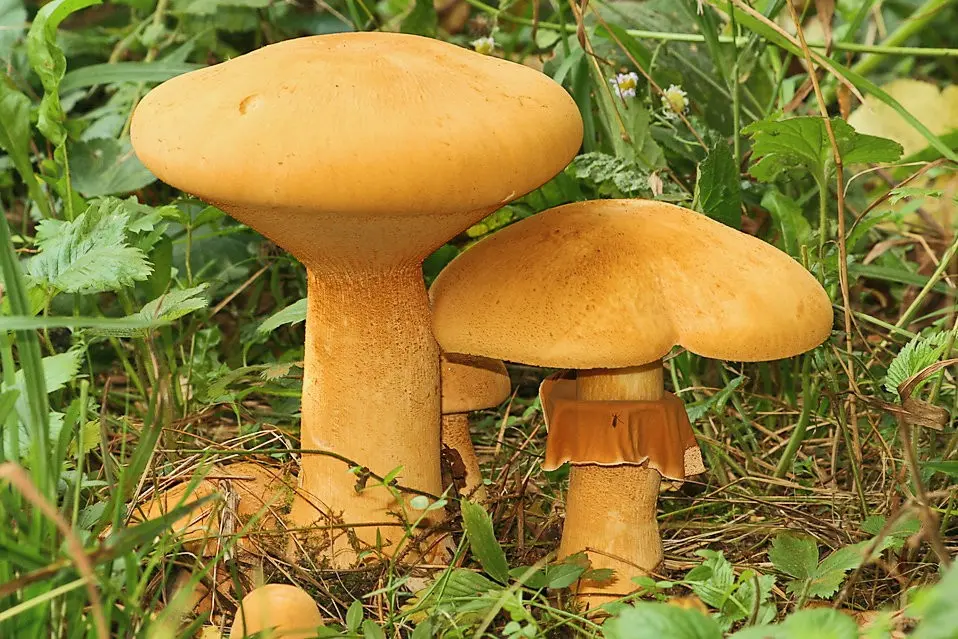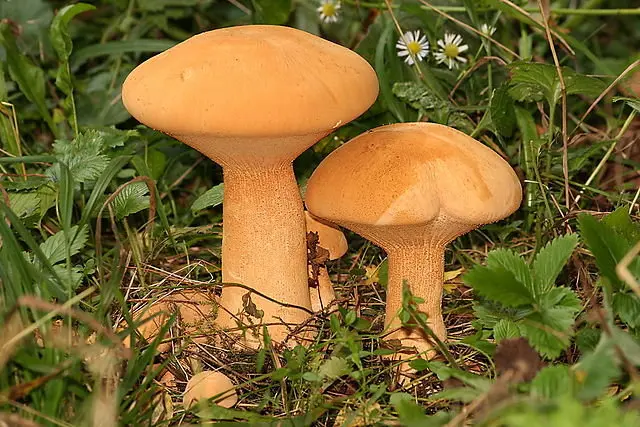Phaeolepiota golden (Phaeolepiota aurea)
- Division: Basidiomycota (Basidiomycetes)
- Subdivision: Agaricomycotina (Agaricomycetes)
- Class: Agaricomycetes (Agaricomycetes)
- Subclass: Agaricomycetidae (Agaricomycetes)
- Order: Agaricales (Agaric or Lamellar)
- Family: Agaricaceae (Champignon)
- Genus: Phaeolepiota (Feolepiota)
- Type: Phaeolepiota aurea (Phaeolepiota golden)
- Umbrella golden
- Mustard plant
- Scale grass
- Agaricus aureus
- Pholiota aurea
- Togaria aurea
- Cystoderma aureum
- Agaricus vahlii

head with a diameter of 5-25 cm, in youth from hemispherical to hemispherical-campanulate, with age becomes convex-prostrate, with a small tubercle. The surface of the cap is matte, granular, bright golden yellow, ocher yellow, ocher in color, an orange tint is possible. The edge of the cap of mature mushrooms may have fringed remnants of a private veil. The granularity of the cap is more pronounced at a young age, up to scaly, with age it decreases, until it disappears. At a young age, along the edge of the cap, at the point of attachment of the private veil, a strip of a darker shade may appear.
Pulp white, yellowish, may be reddish in the stem. Thick, meaty. Without any special smell.
Records frequent, thin, curved, adherent. The color of the plates is from whitish, yellowish, pale ocher, or light clay when young, to rusty brown in mature mushrooms. In young mushrooms, the plates are completely covered with a dense membranous private veil of the same color as the cap, perhaps a slightly darker or lighter shade.
spore powder rusty brown. Spores are oblong, pointed, 10..13 x 5..6 μm in size.

Leg 5-20 cm high (up to 25), straight, with a slight thickening at the base, possibly widened in the middle, granular, matte, longitudinally wrinkled, gradually turning into a private spathe at a young age, also granular, radially wrinkled. At a young age, the granularity is strongly pronounced, up to scaly. The color of the stem is the same as that of the bedspread (like a hat, perhaps a darker or lighter shade). With age, the spathe bursts, leaving a wide hanging ring on the stem, the color of the stem, with brown or brown-ocher scales that can cover almost, if not all of its area, giving the spathe a completely brown appearance. With age, to the old age of the fungus, the ring noticeably decreases in size. Above the ring, the stem is smooth, at a young age it is light, the same color as the plates, it may have whitish or yellowish small flakes on it, then, with the maturation of spores, the plates begin to darken, the leg remains lighter, but then it also darkens, reaching the same rusty-brown color as the plates of the old fungus.

Theolepiota golden grows from the second half of July until the end of October, in groups, including large ones. Prefers rich, fertile soils – meadows, pastures, fields, grows along roads, near nettles, near shrubs. It can grow in clearings in light deciduous and larch forests. The fungus is considered rare, listed in the Red Book of some regions of Our Country.
There are no similar species of this fungus. However, in photographs, when viewed from above, the pheolepiote can be confused with a ringed cap, but this is only in photographs, and only when viewed from above.
Previously, golden pheolepiota was considered a conditionally edible mushroom, which is eaten after 20 minutes of boiling. However, now the information is contradictory, according to some reports, the fungus accumulates cyanides, and can lead to poisoning. Therefore, recently, it has been classified as an inedible mushroom. However, no matter how much I tried, I did not find information that someone was poisoned by it.
Photo: from the questions in the “Qualifier”.









